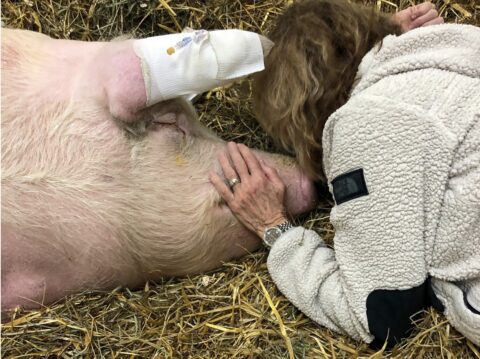News
Octopus Farming in the U.S. Doesn’t Exist, and a New Bill Wants to Keep It That Way
Factory Farms•5 min read
Reported
Farmed animals' access to proper medical care is often limited by their status as “food animals," leaving sanctuary owners with few options for treatment.


Words by Julie Knopp
In July of 2015, Robin Johnson drove to a backyard butcher to pick up the first resident pig for her animal sanctuary in Long Lake, Minnesota. The seller struggled to usher the pig into Johnson’s pick-up, cursing and hitting the pig with a two-by-four. He suddenly threw the plank up in the air and stormed back into his house. He shouted to Johnson that he would no longer sell the pig, but would instead shoot her and hang her from a tree.
Fortunately, Johnson and her partner Buck Weber were able to diffuse the situation and bring the pig, whom they named Libby, to Spring Farm Sanctuary. Driving back, they worried that much time would pass before Libby recovered from the trauma she had experienced and learned to trust people again. But, within hours, Libby was snuggling with Johnson and Weber. “[Libby] showed me love I have never experienced,” Johnson says. Still, an early life spent living amidst raw sewage in a junkyard had weakened Libby’s immune system, which would result in persistent health problems.
In 2018, Libby developed a middle ear infection. Effective treatment required regular doses of an antibiotic called Baytril. (Due to Libby’s complex health history, her options for safe antibiotic treatments were especially limited.) According to the FDA, Libby could receive only one dose of Baytril. FDA regulations pertaining to “food animals” tightly restrict the use of some antibiotics for the purpose of preventing the humans who handle and consume those farmed animal species from developing antibiotic resistance. Johnson, seeking an exemption for Libby, reached out to several different regulatory bodies that govern veterinary medicine in Minnesota—yet none of those authorities were able to identify a decision-maker who could exempt Libby from the restriction. After weeks spent unsuccessfully navigating the bureaucracy, it was too late for Johnson to seek the best course of care, and she had no choice but to pursue a less efficacious solution.
Libby’s vet prescribed another, less effective antibiotic, which partially remedied the infection but did not entirely cure it; the infection resurfaced in full one year later. As revealed by a CT scan, the persistent infection caused substantial bone loss, which would require surgery to repair. Johnson found a veterinarian in New York willing to perform the high-risk operation, which carried for Libby only a 50-50 chance of survival. Weber hauled Libby halfway across the country for the procedure. Libby survived the six-hour surgery and spent 10 days recovering at the facility. But her appetite never returned. Just a few days later, in February of 2020, Johnson and Weber made the difficult decision to put Libby down to end her suffering. “We still haven’t recovered,” Johnson says. “I truly believe she would still be alive today if we [had] been able to treat her the way we needed to [in the beginning] instead of having to try the third, fourth, fifth best thing.”
Spring Farm Sanctuary’s inability to access the best course of treatment for Libby is not unique amongst farmed animal rescue operations. Esther the Wonder Pig, a “celebrity” pig who resides at Happily Ever Esther Farm Sanctuary in Ontario, Canada, faced similar barriers during her struggle with cancer. Regulations established by the Canadian Food Inspection Agency barred Esther in 2018 from receiving chemotherapy for breast cancer. Under Canadian law, “food animals” do not have the right to receive chemotherapy treatments, among other life-saving medicines and procedures. (Fortunately for Esther, the surgical removal of her tumors was successful, and chemotherapy was no longer needed.) Many sanctuaries, beyond facing restricted access to critical medical care for their residents, struggle even to find quality primary care. Veterinarians, who can legally refuse to provide care, often prefer to treat only non-farmed animals like cats and dogs. Access to proper medical care for sanctuary residents is too often limited by their status as “food animals.”
Modern veterinary care of farmed animals is designed to maximize the animals’ economic productivity without overtly jeopardizing human health. Farmed animals are valued solely for their edible products and the associated profits, rather than as inherently worthy creatures. Farmers seeking to prevent illness stemming from cramped, unhygienic conditions and accelerate their animals’ growth routinely administer excessive amounts of antibiotics. Such excessive administration, and the rising incidence of antimicrobial resistance in both animals and humans, is what provoked the FDA to restrict the quantities of some antibiotics, like Baytril, available to farmed animals. These quantity-based restrictions are species-based, and apply equally to factory-farmed animals as to rescued animals in farm sanctuaries. Even though rescued animals like Libby will never be consumed as food, life-saving medications and procedures remain off-limits to her and other sanctuary residents. Traditional companion animals like dogs and cats, which are not consumed by humans, do not face such systemic barriers to treatment; their medical options are not limited by their grisly fate as food. The species of an animal, at present, unequivocally determines the quality of veterinary care to which the individuals of that species have access.
Sanctuaries like Spring Farm exist precisely to provide refuge to some of the most abused animals on the planet—farmed or “food” animals. Most cows, pigs, goats, and chickens around the world suffer miserable lives on factory farms. They live in extreme confinement with little or no access to sunlight or grass, before being prematurely killed for their meat. Occasionally, farm sanctuaries can rescue one or more of these individuals when they escape or are discarded by the industry. These few fortunate animals find safe havens for the rest of their lives at farm sanctuaries. Over the past 30 years, as factory farming has grown, a new wave of compassion for farmed animals has led to the founding of roughly 100 sanctuaries nationwide. In Minnesota, the number of documented sanctuaries has increased dramatically from one to eight over the past ten years. Collectively, farm sanctuaries nationwide perform important and much-needed work; they have rescued and rehabilitated tens of thousands of farmed animals.
Libby’s life was cut short, but it didn’t have to be. Proper veterinary care for animals, just like adequate health care for humans, saves lives. Yet medical treatments for sanctuary residents like Libby will be unfairly restricted so long as the overuse of antibiotic drugs on factory farms continues. The FDA and state veterinary authorities can and should adapt their blanket policies and bureaucratic procedures to provide for more equitable treatment of rescued animals. As the injustices of factory farming become more widely known and sanctuaries increase in number, more people and organizations are rescuing farmed animals—offering much-needed loving homes for species that have traditionally been valued only as edible commodities. Sanctuary owners like Johnson perform crucial work by dedicating their lives to providing care for farmed animals, most of whom have known unimaginable cruelty; they should not be needlessly thwarted by misguided restrictions on essential medicines.
“These animals know their [own] names. They’re capable of love, and they have very distinct personalities,” Johnson says. “We want to be able to treat them like we do our dogs and cats because the love is no different. The system needs to change.”